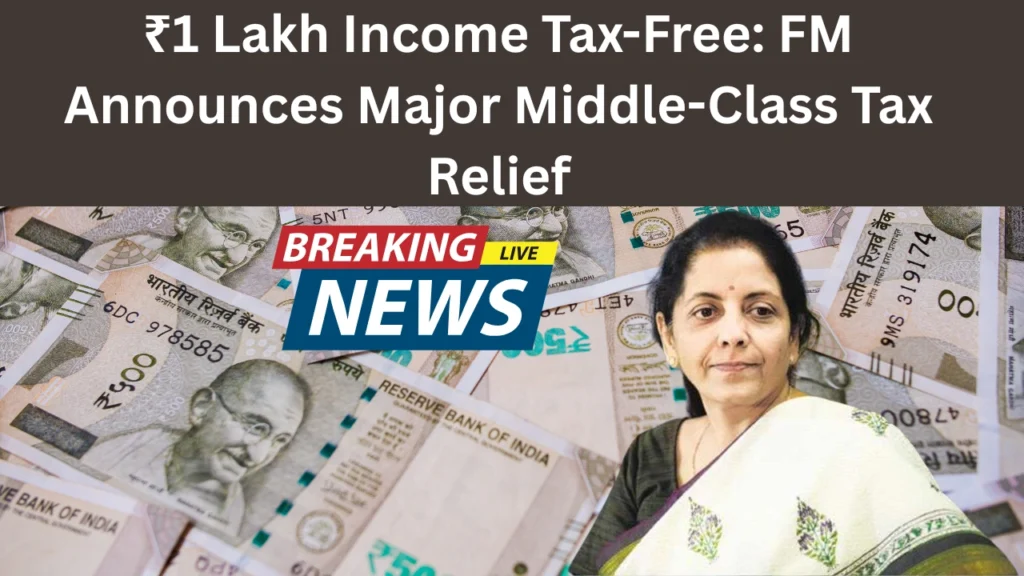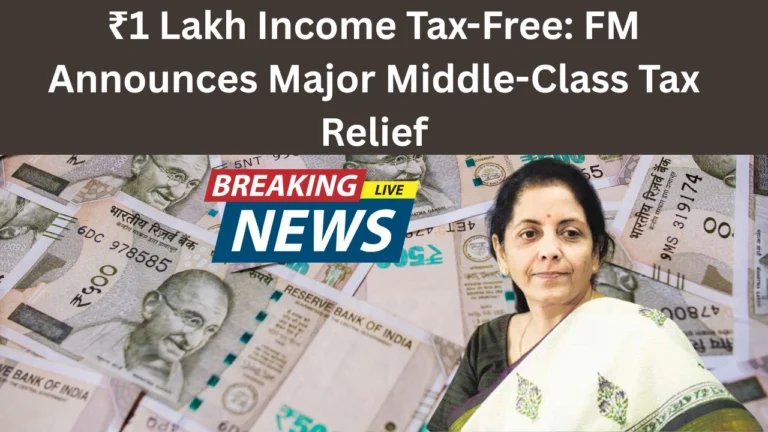₹1 Lakh Income Now Tax-Free : In a groundbreaking move set to benefit millions of middle-class Indians, Finance Minister Nirmala Sitharaman announced a major tax relief during the 2025 Union Budget. Under the new policy, individuals earning up to ₹12 lakh annually will now pay zero income tax, significantly easing the financial burden on salaried households. Additionally, the standard deduction for salaried taxpayers has been raised to ₹75,000, effectively increasing the tax-free income threshold to ₹12.75 lakh. This bold reform is expected to boost disposable income, encourage savings, and stimulate consumer spending across the country.

₹1 Lakh Income Tax-Free — FM The recently announced program will dramatically reduce income tax burdens on middle-class Indian households, changing millions of lives. During the 2025 Union Budget, Finance Minister Nirmala Sitharaman announced that individuals earning up to ₹12 lakh will no longer pay income tax. An enhanced standard deduction of ₹75,000 boosts the tax-free threshold for salaried taxpayers to ₹12.75 lakh.
₹1 Lakh Income Now Tax-Free
In summary, the new tax relief announced by Finance Minister Nirmala Sitharaman represents a bold and transformative shift in India’s fiscal approach. With the tax-free income threshold now raised to ₹12 lakh—and effectively ₹12.75 lakh for salaried individuals—the policy is set to provide substantial relief to middle-class taxpayers. This move is expected to boost consumption, encourage savings, and energize economic activity at the grassroots level. While the government projects an annual revenue loss of approximately ₹1 trillion, it views this as a strategic investment in long-term growth. By empowering the middle class with greater financial freedom, this reform strengthens the economic engine of the nation and sets the stage for a more inclusive and resilient future.
In conclusion, Finance Minister Nirmala Sitharaman’s tax relief is a bold and transformative fiscal move for India. The tax-free income threshold has been raised to ₹12 lakh, effectively ₹12.75 lakh for salaried individuals, offering significant relief to middle-class taxpayers. This should promote consumption, savings, and grassroots economic activity. The government sees an annual income loss of ₹1 trillion as a strategic investment for long-term growth. This reform enhances the economy and creates a more inclusive and resilient future by giving the middle class more financial freedom.
Understanding the New Tax Relief: A Comprehensive Guide
What Does the New Policy Mean?
- Individuals earning up to ₹12 lakh annually pay zero income tax.
- Salaried employees benefit from an increased standard deduction of ₹75,000, raising the effective tax-free limit to ₹12.75 lakh.
- Example: If you earn ₹12.5 lakh as a salaried individual, your income becomes non-taxable after the standard deduction.
Revised Tax Slabs for Higher Incomes
- For income above ₹12 lakh, new progressive tax slabs apply:
- ₹12–16 lakh → 15% tax
- ₹16–20 lakh → 20% tax
- ₹20–24 lakh → 25% tax
- Above ₹24 lakh → 30% tax
- ₹12–16 lakh → 15% tax
- These rates are lower and more balanced than the previous regime.
- Tip: Use the Income Tax Department’s calculator to estimate your tax liability.
Historical Context and Comparison
- 2014: Tax-free limit raised to ₹2.5 lakh
- 2019: Increased to ₹5 lakh
- 2023: Further raised to ₹7 lakh
- 2025: Now increased to ₹12 lakh (₹12.75 lakh for salaried individuals)
- Shows a consistent effort to ease tax burden on the middle class over the years.
Why the Change?
- Boost consumer spending by increasing disposable income
- Encourage savings and investments with lower tax pressure
- Stimulate economic growth in key sectors facing slowdowns
- Help counter challenges like inflation and weak manufacturing output
Impact on Various Sectors
- Retail & FMCG: Increased household income may drive up sales
- Automotive: Higher affordability could boost vehicle purchases
- Real Estate: Greater spending power may revive housing demand
- Financial Services: Potential rise in bank deposits and investments as people save more
The 2025 Union Budget’s bold tax relief empowers India’s middle class and boosts the economy. With tax-free income up to ₹12 lakh and ₹12.75 lakh for salaried individuals, the government has greatly enhanced disposable income for millions. This change should enhance consumer spending, savings, and investments in retail, automotive, real estate, and financial services. With altered tax bands for higher earnings and a focus on economic revival, this strategy transforms India’s fiscal landscape, giving residents more financial control.
Practical Guide: How to Adapt to the New Tax Regime
Assess Your Total Income
- Identify all sources of income:
- Salary income
- Business income (if applicable)
- Investment income (dividends, interest, capital gains)
- Other sources (rent, freelance work, etc.)
Apply the Standard Deduction
- Salaried employees can claim a ₹75,000 standard deduction from gross income
- This helps lower your net taxable income
- Tip: Keep documents like salary slips and bank statements ready for accurate reporting
Determine Your Tax-Free Limit
- Salaried taxpayers: No tax if net income is ₹12.75 lakh or below
- Other taxpayers: No tax if net income is ₹12 lakh or below
Calculate Tax on Excess Income
- If your net income exceeds the tax-free limit, apply the following tax slabs:
- ₹12–16 lakh → 15%
- ₹16–20 lakh → 20%
- ₹20–24 lakh → 25%
- Above ₹24 lakh → 30%
- Example
- If your net income is ₹15.25 lakh, the first ₹12.75 lakh is tax-free
- The remaining ₹2.5 lakh is taxed at 15% = ₹37,500
- Step 5: File Your Income Tax Returns
- Accurately file returns using reliable tax software or a certified tax professional
- Ensure you claim all eligible deductions, rebates, and exemptions
- Meet deadlines to avoid penalties and stay compliant
Adapting to the new tax regime requires understanding your overall annual revenue, including salaries, business profits, investment returns, and others. Revised standard deduction of ₹75,000 lowers taxable income for salaried individuals, enabling many to slip below the new tax-free threshold of ₹12.75 lakh. Those with net income qualify for the ₹12 lakh exemption. If your income exceeds these limits, use the new progressive slabs—15% to 30% for higher income bands. At 15% tax, only ₹2.5 lakh of your taxable income after deductions will be taxed, resulting in an obligation of ₹37,500. Hold onto documentation, claim all eligible deductions, and file your returns accurately—ideally with tax software or a financial advisor—to maximize this regime.
Expert Opinions and Industry Reactions
Several industry leaders and economic experts have responded positively to the newly introduced tax reforms:
Sanjiv Mehta, Former CEO of Hindustan Unilever
“This is a progressive step that empowers the middle class and boosts consumption. We expect to see a strong uptick in demand across fast-moving consumer goods and essential services.”
Nilesh Shah, MD of Kotak Mahindra Asset Management
“Raising the tax-free income limit to ₹12 lakh is a game-changer. It not only encourages savings and investments but also gives the financial markets a much-needed tailwind.”
Devina Mehra, Chairperson & MD of First Global
“The policy strikes the right balance between fiscal responsibility and inclusive growth. It supports long-term economic momentum by placing greater trust in the spending power of the average Indian.”
The new tax reforms have sparked a wave of positive reactions from industry leaders and economists, many of whom view the changes as a catalyst for economic revival. Kamala Bali, CEO of Volvo India, stated, “I feel around 25–30 million personal taxpayers will save around ₹1,00,000 annually. This boost in disposable income will drive capital expenditure in sectors like automotive and retail.” Echoing this sentiment, Anitha Rangan, Economist at Equirus, noted, “Tax reforms of this magnitude provide a much-needed stimulus for the economy, especially by strengthening the middle class, which is the backbone of consumer demand.” Meanwhile, Radhika Gupta, MD & CEO of Edelweiss Asset Management, remarked, “This budget boldly addresses the need of the hour by putting money directly in the hands of the middle class. It is a strategic move to ensure long-term economic growth.” Collectively, these expert views suggest that the reforms are expected to boost consumer confidence, increase spending, and support sustained growth across various industries.
FAQ’s
Do I need to do anything to claim this benefit?
No special action is required. When you file your income tax return for the financial year 2025–26, the new rules will automatically apply based on your income and deductions.
Who benefits from the new tax-free limit?
Salaried individuals with net income up to ₹12.75 lakh and other taxpayers with net income up to ₹12 lakh pay zero income tax under the new regime.
Is this reform seen as a long-term solution?
Yes. According to industry leaders like Radhika Gupta and Sanjiv Mehta, the reform is a long-term investment in India’s economic resilience, aiming to create a more robust and inclusive growth environment.

